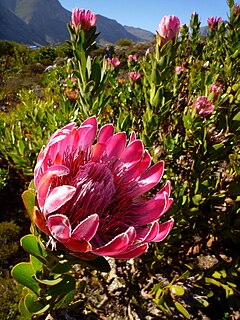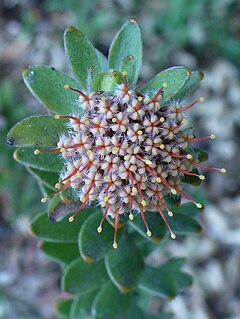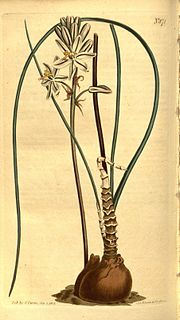
Haworthia is a large genus of small succulent plants endemic to Southern Africa (Mozambique, Namibia, Lesotho, Eswatini and South Africa).

Myoporum is a genus of flowering plants in the figwort family, Scrophulariaceae. There are 30 species in the genus, eighteen of which are endemic to Australia although others are endemic to Pacific Islands, including New Zealand, and one is endemic to two Indian Ocean islands. They are shrubs or small trees with leaves that are arranged alternately and have white, occasionally pink flowers and a fruit that is a drupe.

Gasteria is a genus of succulent plants, native to South Africa.

Protea compacta is similar to Protea eximia. Its distribution is from the Kleinmond to Bredasdorp Mountains and is one of the best known proteas in the cut flower industry. Its leaves curve upward.
Illicium tenuifolium is a species of flowering plant in the family Schisandraceae. It is a tree native to Indo-China and Peninsular Malaysia. It grows in tropical forests, including cloud forest.

Curio archeri, syn. Senecio toxotis is a species of succulent plant in daisy family that is indigenous to the south-western Cape, South Africa.

Microloma sagittatum, the bokhoring, is a species of plant in the family Apocynaceae, that is native to the south-western Cape, South Africa.

Leucospermum prostratum is a trailing shrub of up to 4 m (13 ft) in diameter from the Proteaceae. It has alternately set, about 3 cm (1.2 in) long, lance-shaped, olive-colored, upright leaves, and produces sweetly scented, compact, hemispherical flower heads, with long styles sticking out far from the perianth tube, which jointly give the flower head the appearance of a pincushion. The fragrant flowers found between July and December are initially yellow but turn orange when older. It is an endemic species restricted to the south coast of the Western Cape province of South Africa. Its common name is yellow-trailing pincushion.

Serruria fasciflora or common pin spiderhead is a species of flowering plant in the family Proteaceae. It is a sprawling to upright shrublet of 40 cm to 1 m high and about ½ m wide. It has finely divided, upward curving leaves with thread-thin segments and clusters of sweetly scented heads, each consisting of five to seven silvery pink flowers, that may be found year-round, but mostly from May to December. It is a rather widespread and common species, that is restricted to the south of the Western Cape province of South Africa.

Leucospermum truncatulum is a slender, upright, evergreen, hardly branching shrub of up to 2 m (6 ft) high, with felty inverted egg-shaped to oval, leaves with entire margins of 1–2½ cm (0.4–1.0 in) long and ½–1 cm (0.2–0.4 in) wide. It has small globe-shaped, at first yellow, later pinkish flower heads of 1½–2 cm (0.6-0.8 in) in diameter, without a stalk, usually crowded with two to eight together near the end of the stems. It is known as oval-leaf pincushion in English, and patrysbos or kleinkopspeldekussing in Afrikaans. It is an endemic species of the south of the Western Cape province of South Africa, and flowers between August and December.

Leucospermum heterophyllum is a low, trailing evergreen shrublet of up to 15 cm (6 in) high, and up to several m in diameter, which is assigned to the family Proteaceae. It has narrow leaves of about 2½ cm (1 in) long and ½ cm (0.2 in) wide, mostly with three teeth near its tip. It has small, globe-shaped, whitish flower heads. It is called trident pincushion in English and rankluisie in Afrikaans. It naturally occurs in the Western Cape province of South Africa. The plant flowers between August and January.

Leucospermum grandiflorum is an evergreen, upright shrub of up to 2½ m high that is assigned to the family Proteaceae. It has elliptic, greyish green, softly hairy leaves and initially egg-shaped heads with yellow flowers, later flatter with flowers turning orange. From the center of each flower emerges a long pale yellow style with a pink thickened tip that is bent slightly clockwise, giving the entire head the appearance of a pincushion. Its flowers can be found between July and December. It is called grey-leaf fountain-pincushion or rainbow pincushion in English. L. grandiflorum is an endemic species that can only be found in nature in the Western Cape province of South Africa.

Leucospermum vestitum is an evergreen, upright to more or less spreading shrub of up to 2½ m (9 ft) high and wide from the family Proteaceae. It has greyish, seated, oblong, 2–3 inch long leaves with two to four teeth near the tip and large, showy two-toned flower heads that are bright orange at first by and age to brilliant crimson. From the center of the perianth emerge long styles, higher up bending towards the center of the head, that jointly give the impression of a pincushion. It is called silky-haired pincushion in English and bergluisie in Afrikaans. It can be found in the Western Cape province of South Africa, and flowers from July until January, peaking October and November.

Leucospermum pedunculatum is an evergreen, low shrub of 15–30 cm (½–1 ft) high spreading from a single stern upright stem, from the family Proteaceae. The powdered or hairless line-shaped to somewhat sickle-shaped leaves are 3–6 cm (1.2–2.4 in) long and 2–5 mm (0.08–0.20 in) wide. The stalked, individually set flower heads are globe-shaped, 2½−3 cm in diameter consist of initially white to pale cream flowers that eventually turn carmine. From the center of the flowers emerge straight styles that jointly give the impression of a pincushion. It is called white-trailing pincushion in English. It flowers from August to January, peaking in September. It is an endemic species that is restricted to a narrow strip on the south coast of the Western Cape province of South Africa.

Leucospermum secundifolium is a low, evergreen shrub that grows along the ground, the tip of the branches slightly rising, which ihs been assigned to the family Proteaceae. It has narrowly elliptic leaves with a distinct leafstalk, and few-flowered and very small heads of 1–1½ cm (0.4–0.6 in) across. It is called stalked pincushion in English. The sweetly scented flower heads may be found around early December. It is an endemic species that only grows in a small area of the Western Cape province of South-Africa.

Drimia exuviata ("Gifbol") is a species of flowering plant in the family Asparagaceae, subfamily Scilloideae, indigenous to the south-western parts of South Africa.

Euphorbia tuberosa, commonly known as '"milkball/melkbol"' or '"wilderamenas"', is a variable geophytic plant of the family Euphorbiaceae, indigenous to the western parts of South Africa.

Cephalophyllum purpureo-album is a plant species in the family Aizoaceae, endemic to the Western Cape Province, South Africa.

Protea pendula, also known as the nodding sugarbush or arid sugarbush, is a flowering plant of the genus Protea, in the family Proteaceae, which is only found growing in the wild in the Cape Region of South Africa. In the Afrikaans language it is known as knikkopsuikerbossie or ondersteboknopprotea.
Eriospermum bayeri is a species of geophytic plant of the genus Eriospermum, indigenous to the Western Cape Province, South Africa.



















